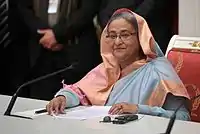Awami League
The Bangladesh Awami League (Bengali: বাংলাদেশ আওয়ামী লীগ, romanized: Bānglādēsh Awāmī Līg, lit. 'Bangladesh People's League'), often simply called the Awami League or AL,[7][8] is a centrist[4][5] to centre-left[6] political party in Bangladesh and one of the major political parties in Bangladesh, being the ruling party of Bangladesh since 2009. [9]
Bangladesh Awami League বাংলাদেশ আওয়ামী লীগ Bangladesh People's League | |
|---|---|
 | |
| Abbreviation | AL |
| President | Sheikh Hasina |
| General Secretary | Obaidul Quader |
| Jatiya Sangsad leader | Sheikh Hasina (Leader of the House) |
| Founders | Abdul Hamid Khan Bhashani Sheikh Mujibur Rahman Shawkat Ali Yar Mohammad Khan Shamsul Huq |
| Founded | 23 June 1949 |
| Split from | Muslim League |
| Preceded by | Awami Muslim League |
| Headquarters | 23 Bangabandhu Avenue, Dhaka |
| Newspaper | Uttaran |
| Think tank | Centre for Research and Information |
| Student wing | Bangladesh Chhatra League |
| Youth wing | Awami Jubo League |
| Women's wing | Mohila Awami League |
| Farmer wing | Krishak League |
| Trade union wing | Jatiya Sramik League |
| Volunteer wing | Awami Swechasebak League |
| Armed wing | Rakkhi Bahini (1972–1975) |
| Ideology | Bengali nationalism[1][2][3] Secularism[1] Social democracy[1] |
| Political position | Centre[4][5] to centre-left[6] |
| National affiliation | Grand Alliance |
| Colors | Green |
| Slogan | "Joy Bangla" (Bengali) "Victory to Bengal" |
| Anthem | "Pralayollas" (Bengali) "The Ecstasy of Destruction" |
| Seats in Jatiya Sangsad | 299 / 350 |
| Mayors in City Corporations | 10 / 12 |
| Election symbol | |
 | |
| Party flag | |
 | |
| Website | |
| albd | |
| |
The All Pakistan Awami Muslim League was founded in Dhaka, the capital of the Pakistani province of East Bengal, in 1949 by Bengali nationalists Abdul Hamid Khan Bhashani, Shawkat Ali, Yar Mohammad Khan, and Shamsul Huq, and joined later by Huseyn Shaheed Suhrawardy who went on to become Prime Minister of Pakistan. The Pakistan Awami Muslim League was established as the Bengali alternative to the domination of the Muslim League in Pakistan and over centralisation of the government. The party quickly gained a massive popular support in East Bengal, later named East Pakistan, and eventually led the forces of Bengali nationalism in the struggle against West Pakistan's military and political establishment.
The party under the leadership of Sheikh Mujibur Rahman, led the struggle for independence, first through massive populist and civil disobedience movements, such as the Six Point Movement and 1971 Non-Cooperation Movement, and then during the Bangladesh Liberation War.
After the emergence of independent Bangladesh, the Awami League won the first general elections in 1973 but was overthrown in 1975 after the assassination of Sheikh Mujibur Rahman. The party was forced by subsequent military regimes onto the political sidelines, and many of its senior leaders and activists were executed or jailed. After the restoration of democracy in 1990, the Awami League emerged as one of the principal players of Bangladeshi politics. Since 2009, when the Awami League came to power, Bangladesh has experienced democratic backsliding.[10]
Amongst the leaders of the Awami League, five have become the President of Bangladesh, four have become the Prime Minister of Bangladesh and one became the Prime Minister of Pakistan. The incumbent Prime Minister of Bangladesh, Sheikh Hasina, has headed the party since 1981.
The Bangladesh Awami League's modern foreign policy is to maintain good foreign relations with all countries, including the US, the UK, France, and Germany as well as Russia and China.
History
Founding and early Pakistan era (1949–66)
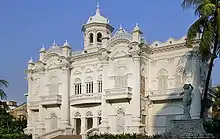
During the post-Mughal era no political parties existed in the area known as Bangla or Bangal. After the British arrived and established government, the system of political representation (though much later) was adopted in the area of Bangla (Bengal) or introduced in Bengal. After the official departure of the British, the area known as East Bengal became a part of Pakistan, and the establishment of the Muslim was led by its founder Muhammad Ali Jinnah and his Muslim League party.
In 1948, there was rising agitation in East Bengal against the omission of Bengali script from coins, stamps and government exams. Thousands of students, mainly from the University of Dhaka, protested in Dhaka and clashed with security forces. Prominent student leaders including Shamsul Huq, Khaleque Nawaz khan, Shawkat Ali, Kazi Golam Mahboob, Oli Ahad, and Abdul Wahed were arrested and the police were accused of repression while charging protesters. In March, senior Bengali political leaders were attacked whilst leading protests demanding that Bengali be declared an official language in Pakistan. The leaders included A. K. Fazlul Huq, the former Prime Minister of undivided Bengal.[11] Amidst the rising discontent in East Bengal, Jinnah visited Dhaka and announced that Urdu would be sole state language of Pakistan given its significance to Islamic nationalism in South Asia.[12] The announcement caused an emotional uproar in East Bengal, where the native Bengali population resented Jinnah for his attempts to impose a language they hardly understood on the basis of upholding unity. The resentment was further fuelled by rising discrimination against Bengalis in government, industry, bureaucracy and the armed forces and the dominance of the Muslim League. The Bengalis argued that they constituted the ethnic majority of Pakistan's population and Urdu was unknown to the majority in East Bengal.[13] Moreover, the rich literary heritage of the Bengali language and the deep rooted secular culture of Bengali society led to a strong sense of linguistic and cultural nationalism amongst the people of East Bengal. The only significant language in Pakistan not written in the Persian-Arabic script was Bengali.[14] Against this backdrop, Bengali nationalism began to take root within the Muslim League and the party's Bengali members began to take a stand for recognition.
On 23 June 1949, Bengali nationalists from East Bengal broke away from the Muslim League, Pakistan's dominant political party, and established the All Pakistan Awami Muslim League. Maulana Abdul Hamid Khan Bhashani and Shamsul Huq were elected the first president and general secretary of the party respectively, Ataur Rahman Khan was elected the vice-president, Yar Mohammad Khan was elected as the treasurer, while Sheikh Mujibur Rahman, Khondaker Mostaq Ahmad and A. K. Rafiqul Hussain were elected the party's first joint secretaries.[15] The party was formed to champion the rights of the masses in Pakistan against the powerful feudal establishment led by the Muslim League. However, due to its strength stemming from the discriminated Bengali population of Pakistan's eastern wing, the party eventually became associated and identified with East Bengal.
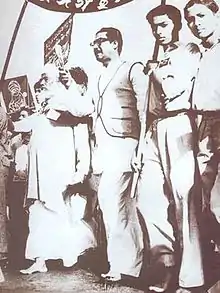
In 1952, the Awami Muslim League and its student wing played an instrumental role in the Bengali Language Movement, during which Pakistani security forces fired upon thousands of protesting students demanding Bengali be declared an official language of Pakistan, famously killing a number of students including Abdus Salam, Rafiq Uddin Ahmed, Abul Barkat and Abdul Jabbar.[16] The events of 1952 are widely seen by historians today as a turning point in the history of Pakistan and the Bengali people, as it was the starting point of the Bengali nationalist struggle that eventually culminated in the creation of Bangladesh in 1971.[15]
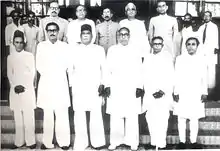
Hussein Shaheed Suhrawardy, who had been the AIML-nominated prime minister of Bengal in 1937 and held the same office after 1946 elections, did not agree to 'Muslim League' as the name of AIML in Pakistan. He initiated the thought that the ideal of political representation under religious identity was no longer prudent after independence and the organisation might be named as Pakistan League. Moreover, he claimed that Muslim League's objective of struggling to form a nation state had been achieved therefore political representation should continue focusing on nationalism based on Pakistani sovereignty. Suhrawardy's suggestion was not accepted, thus, he parted ways with the party to be reestablished as the Awami League in 1949. This was to serve the first shock to the country's political structure. In 1953, the party's council meeting voted to drop the word "Muslim". In the run-up to the East Bengal Legislative Assembly Elections in 1954, the Awami League took the lead in negotiations in forming a pan-Bangla political alliance including the Krishak Praja Party, Nizam-e-Islam and Ganatantrik Dal. The alliance was termed the Jukta Front or United Front and formulated the Ekush Dafa, or 21-point Charter, to fight for establishing rights in East Pakistan. The party also took the historic decision to adopt the traditional Bengali boat, which signified the attachment to rural Bengal, as its election symbol.[15]
The election in April 1954 swept the United Front coalition into power in East Bengal with a massive mandate of 223 seats out of 237 seats. The Awami League itself won 143 seats while the Muslim League won only 9 seats. Veteran student leader and language movement stalwart Khaleque Nawaz Khan defeated incumbent prime minister of the then East Bengal Mr. Nurul Amin in a landslide margin. Mr. Nurul Amin was defeated in his home Nandail constituency. Khaleque Nawaz Khan created history at age 27 by defeating sitting prime minister and Muslim League was wiped out from political landscape of the then East Pakistan. A. K. Fazlul Huq assumed the office of Chief Minister of East Bengal and drew up a cabinet containing many of the prominent student activists that were leading movements against the Pakistani state.[15] They included Sheikh Mujibur Rahman from the Awami League, who served as commerce minister.
Leaders of the new provincial government demanded greater provincial autonomy for East Bengal and eventually succeeded in pressuring Prime Minister Muhammad Ali Bogra, himself a Bengali, to endorse the proposed constitutional recognition of Bengali as an official language of Pakistan. The United Front also passed a landmark order for the establishment of the Bangla Academy in Dhaka.[17] As tensions with the western wing grew due to the demands for greater provincial autonomy in East Bengal, Governor-General Ghulam Muhammad dismissed the United Front government on 29 May 1954 under Article 92/A of the provisional constitution of Pakistan.[15]
In September 1956, the Awami League formed a coalition with the Republican Party to secure a majority in the new National Assembly of Pakistan and took over the central government. Awami League President Huseyn Shaheed Suhrawardy became the Prime Minister of Pakistan. Suhrawardy pursued a reform agenda to reduce the long-standing economic disparity between East and West Pakistan, greater representation of Bengalis in the Pakistani civil and armed services and he unsuccessfully attempted to alleviate the food shortage in the country.[18]
The Awami League also began deepening relations with the United States. The government moved to join the Southeast Asia Treaty Organisation (SEATO) and Central Treaty Organisation (CENTO), the two strategic defence alliances in Asia inspired by the North Atlantic Treaty Organization (NATO). Maulana Bhashani, one of the party's founders, condemned the decision of the Suhrawardy government and called a conference in February 1957 at Kagmari, Tangail in East Bengal. He protested the move and the support lent by the Awami League leadership to the government. Bhashani broke away from the Awami League and then formed the leftist National Awami Party (NAP).[15] Yar Mohammad Khan funded the 5-day Kagmari Conference. He was the treasurer of the kagmari conference committee.
The controversy over One Unit (the division of Pakistan into only two provinces, east and west) and the appropriate electoral system for Pakistan, whether joint or separate, also revived as soon as Suhrawardy became Prime Minister. In West Pakistan, there was strong opposition to the joint electorate by the Muslim League and the religious parties. The Awami League however, strongly supported the joint electorate. These differences over One Unit and the appropriate electorate caused problems for the government.[18]
By early 1957, the movement for the dismemberment of the One Unit had started. Suhrawardy was at the mercy of central bureaucracy fighting to save the One Unit. Many in the business elite in Karachi were lobbying against Suhrawardy's decision to distribute millions of dollars of American aid to East Pakistan and to set up a national shipping corporation. Supported by these lobbyists, President Iskander Mirza demanded the Prime Minister's resignation. Suhrawardy requested to seek a vote of confidence in the National Assembly, but this request was turned down. Suhrawardy resigned under threat of dismissal on 10 October 1957.[18]
On 7 October 1958, President Iskander Mirza declared martial law and appointed army chief General Ayub Khan as Chief Martial Law Administrator. Ayub Khan eventually deposed Mirza in a bloodless coup.[19] By promulgating the Political Parties Elected Bodies Disqualified Ordinance, Ayub banned all major political parties in Pakistan. Senior politicians, including the entire top leadership of the Awami League, were arrested and most were kept under detention till 1963.
In 1962, Ayub Khan drafted a new constitution, modelled on indirect election, through an electoral college, and termed it 'Basic Democracy'. Huseyn Shaheed Suhrawardy joined Nurul Amin, Khwaja Nazimuddin, Maulvi Farid Ahmed and Hamidul Haq Chowdhury in forming National Democratic Front against Ayub Khan's military-backed rule and to restore elective democracy. However the alliance failed to obtain any concessions. Instead the electoral colleges appointed a new parliament and the President exercised executive authority.[15]
Widespread discrimination prevailed in Pakistan against Bengalis during the regime of Ayub Khan. The University of Dhaka became a hotbed for student activism advocating greater rights for Bengalis and the restoration of democracy in Pakistan.[20]
On 5 December 1963, Huseyn Shaheed Suhrawardy was found dead in his hotel room in Beirut, Lebanon. His sudden death under mysterious circumstances gave rise to speculation within the Awami League and the general population in East Pakistan that he had been poisoned.[15]
Struggle for Independence and Mujib era (1966–75)
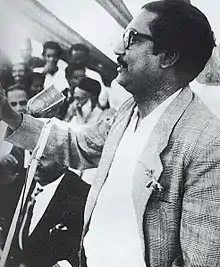
The 6-point demands, proposed by Mujib, were widely accepted by the East Pakistani populace, as they proposed greater autonomy for the provinces of Pakistan. After the so-called Agartala Conspiracy Case, and subsequent end of the Ayub Khan's regime in Pakistan, the Awami League and its leader Sheikh Mujib reached the peak of their popularity among the East Pakistani Bengali population. In the elections of 1970, the Awami League won 167 of 169 East Pakistan seats in the National Assembly but none of West Pakistan's 138 seats. It also won 288 of the 300 provincial assembly seats in East Pakistan.[21][22] This win gave the Awami League a healthy majority in the 313-seat National Assembly and placed it in a position to establish a national government without a coalition partner. This was not acceptable to the political leaders of West Pakistan who feared the 6 points were a step towards breaking up the country and led directly to the events of the Bangladesh Liberation War. A particular point of disagreement was transferring 6 powers to one province which was unprecedented. The Awami League leaders, taking refuge in India, successfully led the war against the Pakistan Army throughout 1971. Leader Sheikh Mujib was arrested by the Pakistan Army on 25 March 1971, but the Bangladeshi people continued the fight to free themselves for nine months.
After victory on 16 December 1971, the party formed the national government of Bangladesh. In 1972, under Sheikh Mujib, the party name was changed to "Awami League". The new government faced many challenges as they rebuilt the country and carried out mine clearing operations. The party had pro Pakistani newspaper editors arrested and shut down the nations' newspapers leaving only four in operation.[23] Food shortages were also a major concern of the Awami League. War had damaged all forms of farming. The party aligned itself with NAM, and leaned towards the Soviet bloc. The party was accused of corruption by supporters of Pakistan. In 1974 Bangladesh suffered a famine: 70,000 people died, and support for Mujib declined. Bangladesh continued exporting jute to Cuba, violating US economic sanctions, the Nixon government barred grain imports to Bangladesh. This exacerbated famine conditions.
In January 1975, facing violent leftist insurgents Mujib declared a state of emergency and later assumed the presidency, after the Awami League dominated parliament decided to switch from parliamentary to a presidential form of government. Sheikh Mujib renamed the League the Bangladesh Krishak Sramik Awami League, and banned all other parties. The consequences lead to a critical political state. BAKSAL was dissolved after the assassination of Sheikh Mujibur Rahman.
The move towards a secular form of government caused widespread dissatisfaction among many low ranking military personnel, most of whom received training from Pakistan army. On 15 August 1975 during the time of K M Shafiullah as a Head of the Army Stuffs. some junior members of the armed forces in Dhaka, led by Major Faruk Rahman and Major Rashid, murdered Sheikh Mujibur Rahman and all his family members, including his wife and minor son. Within months, on 3 November 1975, four more of its top leaders, Syed Nazrul Islam, Tajuddin Ahmed, Captain Muhammad Mansur Ali and A. H. M. Qamaruzzaman were killed inside the Dhaka Central Jail as they were on behalf of BAKSAL. Only Sheikh Hasina and Sheikh Rehana, two daughters of Mujib, survived the massacre as they were in West Germany as a part of a cultural exchange program. They later claimed political asylum in the United Kingdom. Sheikh Rehana, the younger sister, chose to remain in the UK permanently, while Sheikh Hasina moved to India and lived in self-imposed exile. Her stays abroad helped her gain important political friends in the West and in India that proved to be a valuable asset for the party in the future.
Struggle for democracy and Hasina era (1981–present)
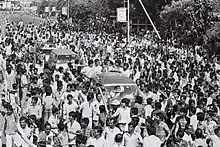
After 1975, the party remained split into several rival factions and fared poorly in the 1979 parliamentary elections held under a military government. In 1981 Sheikh Hasina returned as Ziaur Rahman allowed her to return after the largest party faction, the Awami League elected her its president, and she proceeded to take over the party leadership and unite the factions. As she was under age at the time she could not take part in the 1981 presidential elections that followed the assassination of President Ziaur Rahman. Throughout the following nine years of military rule by General Hossain Mohammad Ershad the Awami League participated in some polls but boycotted most as Ershad did not believe in democracy. On 7 May 1986, Awami League participated in the general election of Bangladesh staged by military ruler Lt Gen Hussain Muhammad Ershad even though the other major political party and the winner of previous elections Bangladesh Nationalist Party boycotted. British observers including a journalists termed the elections a "tragedy for democracy" and a "cynically frustrated exercise".[24]
The Awami League emerged as the largest opposition party in parliament in the elections in 1991, in which Khaleda Zia became the first female prime minister.
AL's second term in office had mixed achievements. Apart from sustaining economic stability during the Asian economic crisis, the government successfully settled Bangladesh's long standing dispute with India over sharing the water of the river Ganges (also known as Padma) in late 1996, and signed a peace treaty with tribal rebels in 1997. In 1998, Bangladesh faced one of the worst floods ever, and the government handled the crisis satisfactorily. It also had significant achievements in containing inflation, and peacefully neutralising a long-running leftist insurgency in south-western districts dating back to the first AL government's time. However, rampant corruption allegations against party office bearers and ministers as well as a deteriorating law and order situation troubled the government. Its pro poor policies achieved wide microeconomic development but that left the country's wealthy business class dissatisfied. The AL's last months in office were marred by sporadic bombing by alleged Islamist militants. Hasina herself escaped several attempts on her life, in one of which two anti-tank mines were planted under her helipad in Gopalganj district. In July 2001, the second AL government stepped down, becoming the first elected government in Bangladesh to serve a full term in office.
The party won only 62 out of 300 parliamentary seats in the elections held in October 2001, despite winning 40% of the votes, up from 36% in 1996 and 33% in 1991. The BNP and its allies won a two-thirds majority in parliament with 46% of the votes cast, with BNP alone winning 41%, up from 33% in 1996 and 30% in 1991.
In its second term in opposition since 1991, the party suffered the assassination of several key members. Popular young leader Ahsanullah Master, a member of parliament from Gazipur, was killed in 2004. This was followed by a grenade attack on Hasina during a public meeting on 21 August 2004, resulting in the death of 22 party supporters, including party women's secretary Ivy Rahman, though Hasina lived. Finally, the party's electoral secretary, ex finance minister, and veteran diplomat Shah M S Kibria, a member of parliament from Habiganj, was killed in a grenade attack in Sylhet later that year.
In June 2005, the Awami League won an important victory when the AL nominated incumbent mayor A.B.M. Mohiuddin Chowdhury won the important mayoral election in Chittagong, by a huge margin, against BNP nominee State Minister of Aviation Mir Mohammad Nasiruddin. This election was seen as a showdown between the Awami League and the BNP. However, the killing of party leaders continued. In December 2005, the AL supported Mayor of Sylhet narrowly escaped the third attempt on his life as a grenade thrown at him failed to explode.[25]
In September 2006, several of the party's top leaders, including Saber Hossain Chowdhury MP and Asaduzzaman Nur MP, were hospitalised after being critically injured by police beatings while they demonstrated in support of electoral-law reforms. Starting in late October 2006, the Awami League led alliance carried out a series of nationwide demonstrations and blockades centring on the selection of the leader of the interim caretaker administration to oversee the 2007 elections. Although an election was scheduled to take place on 22 January 2007 that the Awami League decided to boycott, the country's military intervened on 11 January 2007 and installed an interim government composed of retired bureaucrats and military officers.
Throughout 2007 and 2008, the military backed government tried to root out corruption and remove Sheikh Hasina and Khaleda Zia of the AL and BNP respectively.[26] While these efforts largely failed, they succeeded in producing a credible voter list that was used on 29 December 2008 national election.
The Awami League won the national election held on 29 December 2008 as part of a larger electoral alliance that also included the Jatiya Party led by former military ruler General Hussain Muhammad Ershad as well as some leftist parties. According to the Official Results,[27] Bangladesh Awami League won 230 out of 299 constituencies, and together with its allies, had a total of 262 parliamentary seats. The Awami League and its allies received 57% of the total votes cast. The AL alone got 48%, compared to 36% of the other major alliance led by the BNP which by itself got 33% of the votes. Sheikh Hasina, as party head, became the new Prime Minister. Her term of office began in January 2009.[28] The current cabinet has several new faces, including three women in prominent positions: Dr Dipu Moni (Foreign Minister), Matia Chowdhury (Agriculture Minister) and Sahara Khatun (Home Minister). Younger MPs with a link to assassinated members of the 1972–1975 AL government are Syed Ashraful Islam, son of Syed Nazrul Islam, Sheikh Taposh, son of Sheikh Fazlul Huq Moni, and Sohel Taj, son of Tajuddin Ahmad.
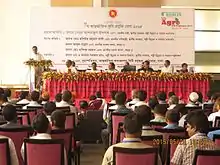
Since 2009, the Awami League government faced several major political challenges, including BDR (Bangladesh Rifles) mutiny,[29] power crisis,[30] unrest in garments industry[31] and stock market fluctuations.[32] Judicial achievements for the party included restoring original 1972 constitution, returning secularism to the constitution,[33] beginning of war crimes trials,[34] and guilty verdict in 1975 assassination trial.[35] According to the Nielsen 2-year survey, 50% felt the country was moving in the right direction, and 36% gave the government a favourable rating.[36]
In the 2014 election the Awami League led alliance won a second term of which 154 Members (out of 300) of Parliament were selected where there were no election . Only 5% voter attended in the polling station and cast their votes. The opposition and one of the most popular parties (BNP) boycotted the election for removing the caretaker government (neutral government) system from the constitution after completion of 5 years tenure.[37][38] With 21 people dead due to the violence during election, along with further human rights abuses and an absence of opposition, this was one of the controversial general elections in Bangladesh's history.[39] This election was further tainted by arrests where dozens of opposition leaders and members were taken into custody.
Name and symbols
.png.webp)
The All Pakistan Awami Muslim League (Urdu: آل پاکستان عوامی مسلم لیگ) or the East Pakistan Awami Muslim League was formed as a breakaway faction of the "All Pakistan Muslim League" in 1949, within two years of the formation of Pakistan. The word Muslim was dropped in 1953 and it became the secular Awami League. During the Bangladesh Liberation War of 1971, most of the Awami League members joined the Provisional Government of Bangladesh and Mukti Bahini guerrillas to fight against the Pakistani army and the name "Bangladesh Awami League" was eventually settled upon.
The most common mascot and electoral symbol for the party has been the boat, which signified the attachment to rural Bengal. Traditionally the party had no consistent colour identity. After the 1991 election, the colour green became associated with Awami League, while blue has become the identifying colour for rival nationalist party.
The salutation "Joy Bangla" (Bengali: জয় বাংলা; meaning Victory to Bengal or "Long live Bengal") is the official slogan of the Awami League. It was the slogan and war cry of the Mukti Bahini that fought for the independence of Bangladesh during the Bangladesh Liberation War in 1971. The phrase "Joy Bangla, Joy Bangabandhu" is used by the party members at the end of speeches and communications pertaining to or referring to patriotism towards Bangladesh and Bangabandhu Sheikh Mujib.
The Awami League party flag is a green field with four five-rayed red star at its centre, and a vertical red stripe at the hoist side. The flag also bears some resemblance to the flag of Pakistan, showing the ex-Pakistani origin of the Awami League. The four stars on the Flag represent the four fundamental principles of the party: nationalism, secularism, socialism, and democracy.
Ideology

The Bangladesh Awami League styles itself as the leader of the "pro-liberation" forces in Bangladesh, promoting secular and social democratic sections of the political establishment in the country. The party constitution states, and in two cases defines the reason for, four fundamental principles in guiding its philosophy and policies.[40] They include:
- Democracy
- Socialism
- Secularism
- Nationalism
Before the 2008 general elections in Bangladesh, the Awami League announced in its manifesto, its "Vision 2021" and "Digital Bangladesh" action plans to transform Bangladesh into a fast-developing middle-income country by 2021.[41] The party uses the term "Shonar Bangla", or golden Bengal, to describe its vision for Bangladesh to become a modern developed nation. The term is reminiscent of Bangladesh's national anthem and a utopian vision in Bengali nationalism.
Prime Minister of Bangladesh Sheikh Hasina supported calls to remove the Statue of Justice in Bangladesh Supreme Court. Many criticized these calls, saying Sheikh Hasina was bowing down to the pressure of Islamist political hard-liners.[42]
In recent years, the party has begun espousing more economically liberal positions, and has moved closer to the centre of the political spectrum.
Organization
.jpg.webp)
Constitution
The Constitution of the Bangladesh Awami League (Bengali: বাংলাদেশ আওয়ামী লীগ এর গঠনতন্ত্র, romanized: Bānlādēśa ā'ōẏāmī līgēra gaṭhanatantra) has 24 Articles and includes contents of General Program, Membership, Organization System, Central Organizations, Name, Aims and Objectives, Fundamental Principles, Commitments. In accordance with the changing situation and tasks, revisions were made in some of the articles at the National Conference.[43]
National Conference
The National Conference NC (Bengali: জাতীয় সম্মেলন, romanized: Jātīẏa sam'mēlana) is the party's highest body, and, since the 1st National Conference in 1949, has been convened every three years (sometimes on an irregular basis). According to the party's constitution, the National Conference may be postponed on except "under extraordinary circumstances." The party constitution gives the NC following responsibilities:
- electing the President
- electing the general secretary
- examining the report of the outgoing Central Working Committee
- discussing and enacting party policies
- revising the party's constitution
In practice, the party councillors and delegates rarely discuss issues at length at the National Conference. Most substantive discussion takes place before the Conference, in the preparation period, among a group of top party leaders. In between National Conferences, the Central Working Committee is the highest decision-making institution.
Central Working Committee
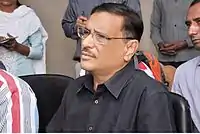
The Central Working Committee (Bengali: কেন্দ্রীয় কার্যনির্বাহী সংসদ, romanized: Kēndrīẏa kāryanirbāhī sansada) of the Awami League is a political body that comprises the top leaders of the Party. It is currently composed of 81 full members and 29 alternate members. Members are elected once every three years by the National Conference of the Bangladesh Awami League.[44][45] The Central Working Committee is made up of the following:
- The Party Presidium:[46]
- The party President;
- 17 Presidium members;
- The general secretary;
- 4 Joint general secretary;
- The Treasurer;
- 28 Additional members;
- 29 Secretaries of the Sub Committee;
- Office Secretary
- Liberation War Affairs secretary
- Finance and planning secretary
- International Affairs secretary
- Law Affairs secretary
- Agriculture and Co-operation secretary
- Information and Research secretary
- Relief and Social welfare secretary
- Religious Affairs secretary
- Press and Publications secretary
- Forest and Environment secretary
- Science and Technology affairs secretary
- Women Affairs secretary
- Youth and Sports affairs secretary
- Education and Human resource secretary
- Industries and Commerce secretary
- Labour and Manpower secretary
- Cultural Affairs secretary
- Health and Population secretary
- 8 Organising secretaries
- Deputy Office-secretary
- Deputy Press-secretary
and
- 10 Parliamentary Committee member
Advisory Council
Almost 38 Advisory Council (Bengali: উপদেষ্টা পরিষদ, romanized: Upadēṣṭā pariṣada) members working as party's think-tank and are not Part of the Central Working Committee The Awami League Advisory Council is the highest governing of Bangladesh Awami League.[45]
Centre for Research and Information
The Centre for Research and Information CRI is the think-tank and research cell of the Awami League. The foundation offers political education, conducts scientific fact-finding research for political projects, grants scholarships to gifted individuals, researches the history of Awami League, and supports and encourages youth, international understanding, and development-policy co-operation.[47][48][49][50][51]
Activities
Wings
| Type | Official Name | Common Term |
|---|---|---|
| Student Wing | Bangladesh Chhatra League | Chhatra League |
| Youth Wing | Bangladesh Awami Jubo League | Jubo League |
| Women's Wing | Bangladesh Mohila Awami League | Mohila League |
| Farmer Wing | Bangladesh Krishak League | Krishak League |
| Trade Union Wing | Bangladesh Jatiya Sramik League | Jatiya Sramik League |
| Volunteer Wing | Bangladesh Awami Swechasebak League | Swechasebak League |
President and general secretary of the AL, 1949–present
| President[54][55] | Elected (National Council; NC) | In Office | Term length | General Secretary[56][57] |
|---|---|---|---|---|
| Abdul Hamid Khan Bhashani | NC: 1949, 53, 55 | 23 June 1949 – 27 July 1956 | 7 years, 34 days | Shamsul Huq Sheikh Mujibur Rahman |
| Huseyn Shaheed Suhrawardy | (acting) | 27 July 1956 – 10 October 1957 | 1 year, 75 days | Sheikh Mujibur Rahman |
| Abdur Rashid Tarkabagish | NC: 1957, 64 | 10 October 1957 – 25 January 1966 | 8 years, 107 days | Sheikh Mujibur Rahman |
| Sheikh Mujibur Rahman | NC: 1966, 70, 72 | 25 January 1966 – 18 January 1974 | 7 years, 358 days | Tajuddin Ahmad Zillur Rahman |
| Muhammad Qamaruzzaman | NC: 1974 | 18 January 1974 – 24 February 1975 | 1 year, 37 days | Zillur Rahman |
| Dissolution (see:BAKSAL) | ||||
| Syeda Zohra Tajuddin (Convenor) | Special Council: 1977 | 4 April 1977 – 16 February 1978 | 318 days | None |
| Abdul Malek Ukil | NC: 1978 | 16 February 1978 – 16 February 1981 | 3 years, 0 days | Abdur Razzaq |
| Sheikh Hasina | NC: 1981, 87, 92, 97, 02, 09, 12, 16, 19 | 16 February 1981– present | 41 years, 262 days | Abdur Razzaq Syeda Sajeda Chowdhury Zillur Rahman Abdul Jalil Sayed Ashraful Islam Obaidul Quader |
State leaders from the AL, 1971–present
President of Bangladesh | |||
| Name | Term in office | ||
|---|---|---|---|
| Sheikh Mujibur Rahman | 1971–1972 | ||
| Abu Sayeed Chowdhury | 1972–1973 | ||
| Mohammad Mohammadullah | 1974–1975 | ||
| Sheikh Mujibur Rahman | 1975 (Assassinated) | ||
| Khondaker Mostaq Ahmad | 1975 (Deposed) | ||
| Abu Sadat Mohammad Sayem | 1975–1977 | ||
| Zillur Rahman | 2009–2013 | ||
| Abdul Hamid | 2013–present | ||
Vice President of Bangladesh | |||
| Name | Term in office | Note | |
|---|---|---|---|
| Syed Nazrul Islam | 1971–1972 | Acting President during the Bangladesh Liberation War.[58] | |
Prime Minister of Bangladesh | |||
| Name | Term in office | ||
|---|---|---|---|
| Tajuddin Ahmad | 1971–1972 | ||
| Sheikh Mujibur Rahman | 1972–1975 | ||
| Muhammad Mansur Ali | 1975 | ||
| Sheikh Hasina | 1996–2001; 2009–present | ||
Electoral history
Jatiya Sangsad elections
| Election | Party leader | Votes | % | Seats | +/– | Position | Government |
|---|---|---|---|---|---|---|---|
| 1973 | Sheikh Mujibur Rahman | 13,798,717 | 73.2% | 293 / 300 |
Government | ||
| 1979 | Asaduzzaman Khan | 4,734,277 | 24.5% | 39 / 300 |
Opposition | ||
| 1986 | Sheikh Hasina | 7,462,157 | 26.2% | 76 / 300 |
Opposition | ||
| 1988 | Boycotted | 0 / 300 |
Extra-parliamentary | ||||
| 1991 | 10,259,866 | 30.1% | 88 / 300 |
Opposition | |||
| February 1996 |
Boycotted | 0 / 300 |
Extra-parliamentary | ||||
| June 1996 |
15,882,792 | 37.4% | 146 / 300 |
Coalition Government | |||
| 2001 | 22,310,276 | 40.02% | 62 / 300 |
Opposition | |||
| 2008 | 33,887,451 | 49.0% | 230 / 300 |
Government | |||
| 2014 | 36,173,883 | 79.14% | 234 / 300 |
Government | |||
| 2018 | 63,523,066 | 74.63% | 257 / 300 |
Government | |||
See also
- Politics of Bangladesh
- List of political parties in Bangladesh
- Bangladesh Nationalist Party
- List of political parties in Pakistan
- National Awami Party
- Awami National Party
- Suchinta Foundation
References
- Jahan, Rounaq (1 August 2014). "Political Parties in Bangladesh" (PDF). www.cmi.no. Retrieved 10 June 2022.
The Awami League which led the struggle for national liberation, self-describes itself as the ‘proliberation force’ in Bangladesh politics committed to promoting secular and social democratic values associated with the nation’s foundational principles: nationalism, democracy, secularism and socialism.
- Therborn, G., and Khondker, H. H. (eds) (2006). Index. In Asia and Europe in Globalization, Leiden, The Netherlands: Brill. Available From: Brill doi:10.1163/9789047410812_016 [Accessed 06 June 2022]
- Khan, Zillur R. “Islam and Bengali Nationalism.” Asian Survey, vol. 25, no. 8, 1985, pp. 834–51. JSTOR, doi:10.2307/2644113. Accessed 6 Jun. 2022.
- Nazneen, Sohela (March 2009). "Bangladeshr Political Party Discourses and Women's Empowerment". South Asian Journal (24): 44–52. ISSN 1729-6242.
- "Bangladesh: Political Trends and Key Players" (PDF). Observer Research Foundation.
- "Bangladesh election: Voters prepare to go to polls amid 'atmosphere of fear' for opposition activists". The Independent. 23 December 2018. Archived from the original on 28 December 2020. Retrieved 12 September 2019.
Politics in Bangladesh has been dominated for years by the rivalry between Ms Hasina’s centre-left, socially and economically liberal Awami League and the more right-wing BNP with Begum Zia at its helm.
- "BSS-13 AL's new office building to be inaugurated tomorrow". Bangladesh Sangbad Sangstha. Archived from the original on 28 December 2020. Retrieved 13 January 2019.
- "The ruling Bangladesh Awami League (AL) party Invited for Poll Talks". 31 October 2018.
- বগুড়ায় আওয়ামী মৎস্যজীবী লীগের কমিটি গঠন. Joy Jugantor (in Bengali). 11 October 2020. Archived from the original on 28 December 2020. Retrieved 11 October 2020.
- Riaz, Ali (21 September 2020). "The pathway of democratic backsliding in Bangladesh". Democratization. 28: 179–197. doi:10.1080/13510347.2020.1818069. ISSN 1351-0347. S2CID 224958514. Archived from the original on 28 December 2020. Retrieved 24 September 2020.
- Al Helal, Bashir (2003). Bhasa Andolaner Itihas [History of the Language Movement] (in Bengali). Dhaka: Agamee Prakashani. pp. 263–265. ISBN 978-984-401-523-4.
- Uddin, Sufia M. (2006). Constructing Bangladesh: Religion, Ethnicity, and Language in an Islamic Nation. The University of North Carolina Press. pp. 1–4. ISBN 0-8078-3021-6.
- Muhammad Shahidullah, The Azad, 29 July 1947
- DeRouen, Karl Jr.; Heo, Uk (2007). Civil Wars of the World: Major Conflicts Since World War II. Santa Barbara, Calif.: ABC-CLIO. p. 594. ISBN 978-1-85109-919-1.
- Hussain, Ahmede (31 July 2009). "Promises to Keep". The Daily Star. Star Weekend Magazine. Archived from the original on 12 May 2017. Retrieved 11 February 2016.
- Dhaka Medical College Hostel Prangone Chatro Shomabesher Upor Policer Guliborshon. Bishwabidyalayer Tinjon Chatroshoho Char Bekti Nihoto O Shotero Bekti Ahoto" (in Bengali). The Azad. 22 February 1952.
- The Azad, 22 April 1954
- "H. S. Suhrawardy Becomes Prime Minister". Story of Pakistan. July 2003. Archived from the original on 4 November 2011. Retrieved 30 April 2013.
- "Ouster of President Iskander Mirza". Story of Pakistan. June 2003. Archived from the original on 28 December 2020. Retrieved 8 April 2016.
- Ray, Jayanta Kumar (1968). Democracy and nationalism on trial: a study of East Pakistan. Indian Institute of Advanced Study. p. 224.
- "General Elections 1970". Story of Pakistan. June 2003. Archived from the original on 28 December 2020. Retrieved 1 November 2015.
- "Islamic Pakistan". ghazali.net. Archived from the original on 28 December 2020. Retrieved 16 December 2004.
- "BNP demands immediate elections". The Financial Express. Dhaka. 14 February 2014. Archived from the original on 28 December 2020. Retrieved 16 February 2014.
- Liton, Shakhawat (28 August 2010). "Ershad's desperate bids go in vain". The Daily Star. Archived from the original on 19 June 2018. Retrieved 9 April 2017.
- "Grenade aimed at Sylhet Mayor". BBC News. 2 December 2005. Archived from the original on 28 December 2020. Retrieved 31 March 2009.
- "Mahfuz Anam secures anticipatory bail". Dhaka Tribune. Archived from the original on 28 December 2020. Retrieved 8 April 2016.
- "2008 Election Results". Bloomberg. 30 December 2008. Retrieved 5 March 2017.
- Tusher, Hasan Jahid (31 December 2008). "Hasina wants to work with opposition". The Daily Star. Archived from the original on 28 December 2020. Retrieved 31 December 2008.
- Ramesh, Randeep (25 February 2009). "Troops' revolt rocks Bangladesh capital". The Guardian. ISSN 0261-3077. Archived from the original on 28 December 2020. Retrieved 8 April 2016.
- "Power crisis likely to end in 2012". The Daily Star. Archived from the original on 28 December 2020. Retrieved 8 April 2016.
- "Garment sector in dire straits". The Daily Star. Archived from the original on 28 December 2020. Retrieved 8 April 2016.
- "Stocks: Party is over. What next?". The Daily Star. Archived from the original on 28 December 2020. Retrieved 8 April 2016.
- "Secularism back". The Daily Star. Archived from the original on 28 December 2020. Retrieved 8 April 2016.
- "US offers to help Bangladesh pursue war crimes trial". BBC News. 13 January 2011. Archived from the original on 28 December 2020. Retrieved 21 June 2018.
- "Bangladesh hangs killers of independence leader Mujib". BBC News. 27 January 2010. Archived from the original on 28 December 2020. Retrieved 22 January 2011.
- "Nielsen Survey, 2 Year Rating". The Daily Star. 6 January 2011. Archived from the original on 28 December 2020. Retrieved 1 November 2015.
- "Economy, stability highlights of Awami League's second successive tenure". bdnews24.com. Archived from the original on 23 April 2016. Retrieved 8 April 2016.
- Barry, Ellen (4 January 2014). "Opposition Party Boycotting Bangladesh Election". The New York Times. ISSN 0362-4331. Archived from the original on 28 December 2020. Retrieved 6 April 2017.
- "Bangladesh has little to celebrate after the most violent election day in its history". The Guardian. 15 January 2014. ISSN 0261-3077. Archived from the original on 28 December 2020. Retrieved 6 April 2017.
- "The Constitution of the Bangladesh Awami League". Bangladesh Awami League. Archived from the original on 15 March 2009.
- "Election Manifesto of Bangladesh Awami League-2008". Bangladesh Awami League. Archived from the original on 30 November 2010.
- Safi, Michael (26 May 2017). "Lady Justice statue in Bangladesh is removed after Islamist objections". The Guardian. Archived from the original on 28 December 2020. Retrieved 11 February 2018.
- "Constitution – Bangladesh Awami League Official Site". Archived from the original on 3 August 2016. Retrieved 23 October 2016.
- "Organisation – Bangladesh Awami League Official Site". Archived from the original on 26 November 2016. Retrieved 23 October 2016.
- "AL keeping party, govt separate?". The Daily Star. 30 October 2016. Archived from the original on 28 December 2020. Retrieved 4 March 2019.
- "Bangladesh Awami League". www.albd.org. Retrieved 7 August 2022.
- "CRI". Archived from the original on 28 December 2020. Retrieved 9 February 2017.
- "1 crore visit Awami League facebook page in 8 days". Bangladesh Sangbad Sangstha. 25 October 2016. Archived from the original on 26 October 2016.
- "iSoftStone plans Bangladesh office following China's 'One Belt, One Road' initiative". bdnews24.com. Archived from the original on 28 December 2020. Retrieved 4 August 2017.
- "Live Telecast of Awami League Conference reaches millions". Albd.org. Archived from the original on 5 August 2017. Retrieved 4 August 2017.
- "DI praises AL's research wing CRI while meeting HPM Sheikh Hasina". Albd.org. Archived from the original on 5 August 2017. Retrieved 4 August 2017.
- "ICT training starts today". The Daily Star. 9 February 2017. Archived from the original on 28 December 2020. Retrieved 4 August 2017.
- "Training to digital lab volunteers begins on Thursday in Dhaka". bdnews24.com. Archived from the original on 28 December 2020. Retrieved 4 August 2017.
- "AL holds 20th council with Sheikh Hasina as longest-serving president". Bangladesh Sangbad Sangstha. 21 October 2016. Archived from the original on 7 November 2016. Retrieved 6 November 2016.
- কতটুকু এগিয়েছে আওয়ামী লীগ. Prothom Alo (Opinion) (in Bengali). 23 June 2016. Archived from the original on 31 December 2017.
- কেমন ছিল আ.লীগের আগের সম্মেলনগুলো. Prothom Alo (in Bengali). 21 October 2016. Archived from the original on 28 December 2020. Retrieved 21 October 2016.
- "Birth of AL: Funds from sale of pens, watches paved the way". The Daily Star. 22 October 2016.
- Jivanta Schottli; Subrata K. Mitra; Siegried Wolf (2015). A Political and Economic Dictionary of South Asia. Routledge. p. 187. ISBN 978-1-135-35576-0. Archived from the original on 28 December 2020. Retrieved 14 January 2020.
External links
 Media related to Bangladesh Awami League at Wikimedia Commons
Media related to Bangladesh Awami League at Wikimedia Commons- Awami League web site Archived 19 September 2019 at the Wayback Machine
